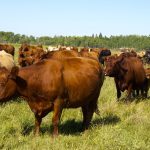
Forages

Researchers examine forage growth and grazing pressure
News Roundup from the April 2024 issue of Canadian Cattlemen

Do you know what’s in your forage mix?
Understanding the benefits and risks of different forages, and whether they fit your goals, are vital to success

Managing grazing through drought
Understanding how plants respond to drought is key to adapting your grazing strategy

Making forage insurance more accessible across Canada
One challenge is insuring a crop for sale versus one for on-farm feed

More N, more yield, less diesel
Perennial forage can keep nitrogen in the soil rather than escaping as greenhouse gas

Overgrazing means less carbon and more methane
Research is demonstrating the importance of legumes in a forage system

Post-calving nutrition to maximize conception rates
Evaluating body condition score can be difficult and requires training

Managing parasite resistance to livestock dewormers
There’s no easy way to extinguish resistance to dewormers, but producers can manage it and control parasites

U.S. seed giant acquires Calgary-based Union Forage
Will continue to operate under Union Forage name in 2024 but status beyond that uncertain

Changing feeding programs after calving
Nutrition with Barry Yaremcio



